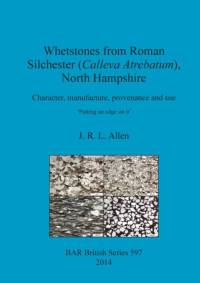Om Whetstones from Roman Silchester (Calleva Atrebatum) North Hampshire Character manufacture provenance and use
The five-hundred year occupation of Insula IX at Silchester has yielded a sequence of 87 whetstones, mostly tabular but some bar- or rod-shaped. These are described, illustrated and characterized with the help of thin-section microscopic petrography. The whetstones originated in many geological sources, not all of which can at present be identified. Whetstones from the earliest levels at Silchester are comparatively local in origin (sarsen, ironstone) or were made from discarded, imported milling stones(Quartz Conglomerate, Upper Old Red Sandstone). During the first and second centuries AD substantial number of bar-shaped whetstones manufactured in the Wroxeter manner from sandstones in the Weald Clay Formation (earliest Cretaceous) were imported into Silchester. Almost all the whetstones of the later Roman period are secondary in character produced from discarded roofing tiles of Brownstones (Lower Old Red Sandstone) and Pennant sandstone (later Upper Carboniferous) imported from the West Country. Small numbers of whetstones can be traced to the Portland Group (Upper Jurassic) and to the Lower and Upper Greens and Groups (Lower Cretaceous). The provision of sharpening stones to Silchester as a whole is estimated to run into many thousands.
Visa mer

